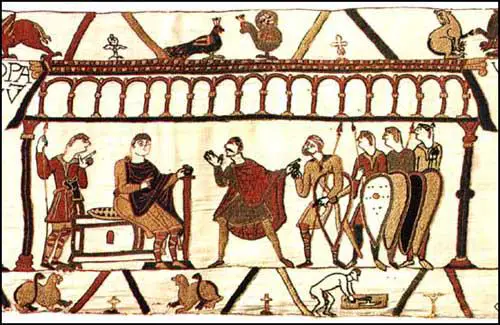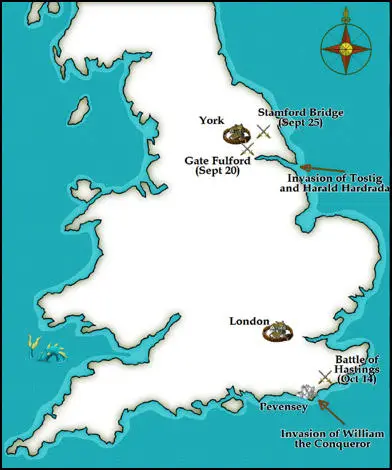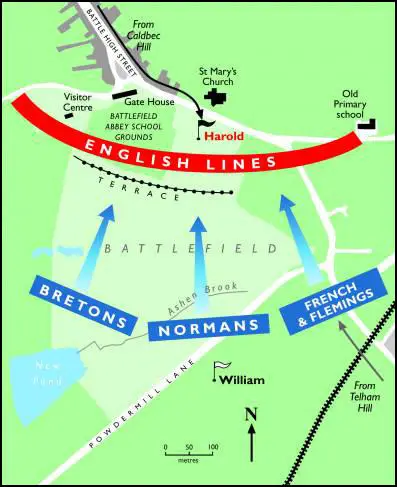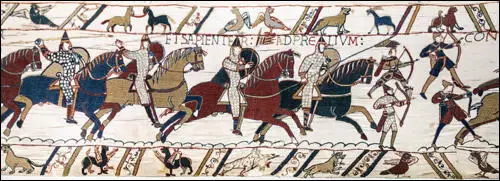The Battle of Hastings
On 17th March 1040, Harold Harefoot died. Edward the Confessor, the seventh son of Ethelred the Unready, returned for exile in Normandy (after the Sweyn Forkbeard invasion in 1013). He was appointed joint king with Harthacnut. However, he died on 8th June, 1042, and as he was childless, Edward took over control of the country. (1)
Edward's main rival was Godwin, the Earl of Wessex. His wife, Gytha, gave birth to a least six sons: Swein, Harold, Tostig, Gyrth, Leofwine and Wulfnoth; and three daughters: Edith, Gunhild and Elfgifu. The birth dates of the children are unknown. (2)
Godwin decided not to try and fight Edward for the throne. Instead, in 1045, Godwin's 20-year-old daughter, Edith, married 42-year-old Edward. Godwin hoped that his daughter would have a son but Edward had taken a vow of celibacy and it soon became clear that the couple would not produce an heir to the throne. Christopher Brooke, the author of The Saxon and Norman Kings (1963), has suggested that this story might have been made up as a part of the legend of royal piety, and as a delicate compliment to a queen who suffered from the common misfortune of failing to bear children." (3)
Edward the Confessor and Earl Godwin
Edward the Confessor became concerned about the growth in power of Earl Godwin and his sons. According to Norman historians, William of Jumieges and William of Poitiers in April 1051, Edward promised William of Normandy that he would be king of the English after his death. David Bates argues that this explains why Earl Godwin, raised an army against the king. The earls of Mercia and Northumbria remained loyal to Edward and to avoid a civil war, Godwin and his family agreed to go into exile. (4) Tostig moved to mainland Europe and married Judith of Flanders in the autumn of 1051. (5) Harold and Leofwine went to seek help in Ireland. Earl Godwin, Swein and the rest of the family went to live in Bruges. (6)
Edward appointed a Norman, Robert of Jumièges, as Archbishop of Canterbury and Queen Edith was removed from court. Jumièges urged Edward to divorce Edith, but he refused and instead she was sent to a nunnery. (7) Edward also appointed other Normans to official positions. This caused great resentment amongst the English and many of them crossed the Channel to offer Godwin their support. (8)
Godwin and his sons were furious by these developments and in 1052 they returned to England with a mercenary army. Edward was unable to raise significant forces to stop the invasion. Most of the men in Kent, Surrey and Sussex joined the rebellion. Godwin's large fleet moved round the coast and recruited men in Hastings, Hythe, Dover and Sandwich. He then sailed up the Thames and soon gained the support of Londoners. (9)
Negotiations between the king and the earl were conducted with the help of Stigand, the Bishop of Winchester. Robert left England and was declared an outlaw. Pope Leo IX condemned the appointment of Stigand as the new Archbishop of Canterbury but it was now clear that the Godwin family was back in control. (10)
At a meeting of the King's Council, Godwin cleared himself of the accusations brought against him, and Edward restored him and his sons to land and office, and received Edith once more as his queen. Earl Swein did not return and instead set off from Bruges on his pilgrimage to Jerusalem, "to look to the salvation of his soul". John of Worcester says that he walked barefoot all the way and that on the journey home he became ill and died in Lycia on 29th September 1052. (11)
Godwin now forced Edward the Confessor to send his Norman advisers home. Godwin was also given back his family estates and was now the most powerful man in England. Earl Godwin died on 15th April, 1053. Some accounts say he choked on a piece of bread. Others say he was accused of being disloyal to Edward and died during an Ordeal by Cake. Another possibility is that he died from a stroke. His place as the leading Anglo-Saxon in England was taken by his eldest son, Harold. (12)
In 1064 Harold was on board a ship that was wrecked on the coast of Ponthieu. He was captured by Count Guy of Ponthieu and imprisoned at Beaurain. William of Normandy, demanded that Count Guy release him into his care. Guy agreed and Harold went with William to Rouen. William later explained what happened: "Edward sent Harold himself to Normandy so that he could swear to me in my presence what his father, Earl Godwin and Earl Leofric (Mercia) and Earl Siward (Northumbria) had sword to me here in my absence. On the journey Harold incurred the danger of being taken prisoner, from which, using force and diplomacy, I rescued him. Through his own hands he made himself my vassal and with his own hand he gave me a firm pledge concerning the kingdom of England." (13)

Godwinson (with mustache) in 1064 Bayeux Tapestry (c. 1090)
In 1065 Edward the Confessor became very ill. Harold claimed that Edward promised him the throne just before he died on 5th January, 1066. (14) The next day there was a meeting of the Witan to decide who would become the next king of England. The Witan was made up of a group of about sixty lords and bishops and they considered the merits of four main candidates: William, Harold, Edgar Etheling and Harald Hardrada. On 6th January 1066, the Witan decided that Harold was to be the next king of England. (15)
King Harold was fully aware that both King Hardrada of Norway and William of Normandy might try to take the throne from him. Harold believed that the Normans posed the main danger and he positioned his troops on the south coast of England. His soldiers were made up of housecarls and the fyrd. Housecarls were well-trained, full-time soldiers who were paid for their services. The fyrd were working men who were called up to fight for the king in times of danger.
Stamford Bridge
Harold waited all summer but the Normans did not arrive. Never before had any of Harold's fyrd been away from their homes for so long. But the men's supplies had run out and they could not be kept away from their homes any longer. Members of the fyrd were also keen to harvest their own fields and so in September Harold sent them home. Harold also sent his navy back to London. (16)
William's attack on England had been delayed. To make sure he had enough soldiers to defeat Harold, he asked the men of Poitou, Burgundy, Brittany and Flanders to help. William also arranged for soldiers from Germany, Denmark and Italy to join his army. In exchange for their services, William promised them a share of the land and wealth of England. William also had talks with Pope Alexander II in his campaign to gain the throne of England. These negotiations took all summer. William also had to arrange the building of the ships to take his large army to England. About 700 ships were ready to sail in August but William had to wait a further month for a change in the direction of the wind. (17)
In early September Harold heard that King Hardrada of Norway had invaded northern England. The messenger told Harold that Hardrada had come to conquer all of England. It is said that Harold replied: "I will give him just six feet of English soil; or, since they say he is a tall man, I will give him seven feet." With Hardrada was Harold's brother, Tostig, and 300 ships. Harold and what was left of his army headed north. Hardrada and his men entered the Humber and on 20th September defeated Morcar's army at Gate Fulford. Four days later the invaders took York. On the way Harold heard that the earls of Mercia and Northumbria had been defeated and were considering changing sides.

The English army marched 190 miles from London to York in just four days. (18) Frank McLynn, the author of 1066: The Year of The Three Battles (1999), has commented "the speed of his advance has always drawn superlatives from historians used to the ponderous pace of medieval warfare, but it may be that a good deal of his force was on horseback and that, as was the custom with Anglo-Saxon armies, they dismounted before fighting." (19)
Peter Rex argues in Harold II: The Doomed Saxon King (2005) that his housecarls were on horseback: "Such mounted infantry could manage twenty-five miles a day. They were also expected to have at least two horses, riding one and allowing the other to proceed unburdened. Harold no doubt could also expect, as king, to commandeer fresh horses along the way. If he did literally ride day and night he could have made Tadcaster in four days, although that would mean without sleep." (20)
On 24th September Harold's army arrived at Tadcaster. The following day he took Tostig and Hardrada by surprise at a place called Stamford Bridge. It was a hot day and the Norwegians had taken off their byrnies (leather jerkins with sewn-on metal rings). Harold and his English troops devastated the Norwegians. Both Hardrada and Tostig were killed. The Norwegian losses were considerable. Of the 300 ships that arrived, less than 25 returned to Norway. (21)
While celebrating his victory at a banquet in York, Harold heard that William of Normandy had landed at Pevensey Bay on 28th September. Harold's brother, Gyrth, offered to lead the army against William, pointing out that as king he should not risk the chance of being killed. "I have taken no oath and owe nothing to Count William". (22)
David Armine Howarth, the author of 1066: the Year of the Conquest (1981) argues that the suggestion was that while Gyrth did battle with William, "Harold should empty the whole of the countryside behind him, block the roads, burn the villages and destroy the food. So, even if Gyrth was beaten, William's army would starve in the wasted countryside as winter closed in and would be forced either to move upon London, where the rest of the English forces would be waiting, or return to their ships." (23)
Harold rejected the advice and immediately assembled the housecarls who had survived the fighting against Hardrada and marched south. Harold travelled at such a pace that many of his troops failed to keep up with him. When Harold arrived in London he waited for the local fyrd to assemble and for the troops of the earls of Mercia and Northumbria to arrive from the north. After five days they had not arrived and so Harold decided to head for the south coast without his northern troops. (24)
Battle of Hastings
When Harold realised he was unable to take William by surprise, he positioned himself at Senlac Hill near Hastings. Harold selected a spot that was protected on each flank by marshy land. At his rear was a forest. The English housecarls provided a shield wall at the front of Harold's army. They carried large battle-axes and were considered to be the toughest fighters in Europe. The fyrd were placed behind the housecarls. The leaders of the fyrd, the thanes, had swords and javelins but the rest of the men were inexperienced fighters and carried weapons such as iron-studded clubs, scythes, reaping hooks and hay forks.
William of Malmesbury reported: "The courageous leaders mutually prepared for battle, each according to his national custom. The English, as we have heard, passed the night without sleep in drinking and singing, and, in the morning, proceeded without delay towards the enemy; all were on foot, armed with battle-axes... The king himself on foot stood with his brother, near the standard, in order that, while all shared equal danger none might think of retreating... On the other side, the Normans passed the whole night in confessing their sins, and received the Sacrament in the morning. The infantry with bows and arrows, formed the vanguard, while the cavalry, divided into wings, were held back." (25)

There are no accurate figures of the number of soldiers who took part at the Battle of Hastings. Historians have estimated that William had about 5,000 infantry and 3,000 knights while Harold had about 2,000 housecarls and 5,000 members of the fyrd. (23) The Norman historian, William of Poitiers, claims that Harold held the advantage: "The English were greatly helped by the advantage of the high ground... also by their great number, and further, by their weapons which could easily find a way through shields and other defences." (26)
At 9.00 a.m. the Battle of Hastings formally opened with the playing of trumpets. Norman archers then walked up the hill and when they were about a 100 yards away from Harold's army they fired their first batch of arrows. Using their shields, the house-carls were able to block most of this attack. Volley followed volley but the shield wall remained unbroken. At around 10.30 hours, William ordered his archers to retreat.

The Norman army led by William now marched forward in three main groups. On the left were the Breton auxiliaries. On the right were a more miscellaneous body that included men from Poitou, Burgundy, Brittany and Flanders. In the centre was the main Norman contingent "with Duke William himself, relics round his neck, and the papal banner above his head". (27)
The English held firm and eventually the Normans were forced to retreat. Members of the fyrd on the right broke ranks and chased after them. A rumour went round that William was amongst the Norman casualties. Afraid of what this story would do to Norman morale, William pushed back his helmet and rode amongst his troops, shouting that he was still alive. He then ordered his cavalry to attack the English who had left their positions on Senlac Hill. English losses were heavy and very few managed to return to the line. (28)
At about 12.00 p.m. there was a break in the fighting for an hour. This gave both sides a chance to remove the dead and wounded from the battlefield. William, who had originally planned to use his cavalry when the English retreated, decided to change his tactics. At about one in the afternoon he ordered his archers forward. This time he told them to fire higher in the air. The change of direction of the arrows caught the English by surprise. The arrow attack was immediately followed by a cavalry charge. Casualties on both sides were heavy. Those killed included Harold's two brothers, Gyrth and Leofwin. However, the English line held and the Normans were eventually forced to retreat. The fyrd, this time on the left side, chased the Normans down the hill. William ordered his knights to turn and attack the men who had left the line. Once again the English suffered heavy casualties.
William ordered his troops to take another rest. The Normans had lost a quarter of their cavalry. Many horses had been killed and the ones left alive were exhausted. William decided that the knights should dismount and attack on foot. This time all the Normans went into battle together. The archers fired their arrows and at the same time the knights and infantry charged up the hill.
It was now 4.00 p.m. Heavy English casualties from previous attacks meant that the front line was shorter. The Normans could now attack from the side. The few housecarls that were left were forced to form a small circle round the English standard. The Normans attacked again and this time they broke through the shield wall and Harold and most of his housecarls were killed. With their king dead, the fyrd saw no reason to stay and fight, and retreated to the woods behind. The Normans chased the fyrd into the woods but suffered further casualties themselves when they were ambushed by the English.
According to William of Poitiers: "Victory won, the duke returned to the field of battle. He was met with a scene of carnage which he could not regard without pity in spite of the wickedness of the victims. Far and wide the ground was covered with the flower of English nobility and youth. Harold's two brothers were found lying beside him." The next day Harold's mother, Gytha, sent a message to William offering him the weight of the king's body in gold if he would allow her to bury it. He refused, declaring that Harold should be buried on the shore of the land which he sought to guard. (29)
